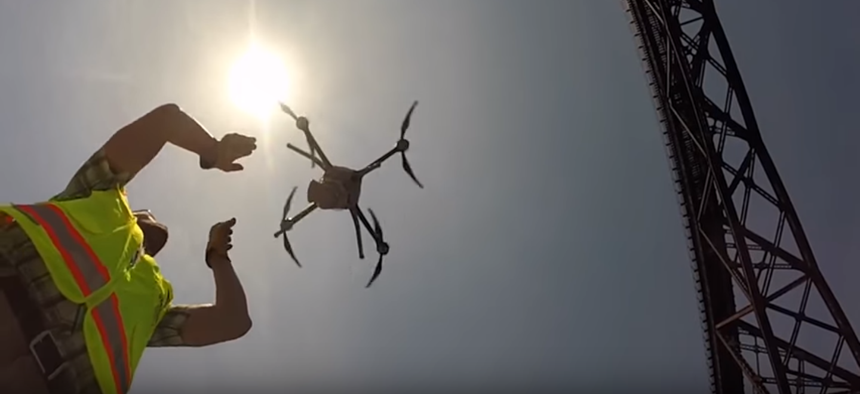State DOTs Are Turning to Drones for Bridge Inspections and Other Work

The agencies see unmanned aircraft as a way to save money and curb risks, according to new information from the American Association of State Highway and Transportation Officials.
State transportation departments across the country are looking to aerial drone technology as a way to save money, reduce hazards for employees and cut down on detours for drivers.
That’s according to information released over the weekend by the American Association of State Highway and Transportation Officials . A new survey by the group, described in a fact sheet , found that 17 state transportation departments had researched or used aerial drones.
Inspecting infrastructure such as bridges, as well as identifying and monitoring areas affected by landslides, rockslides and floods, are among the ways drone technology can be useful for transportation departments, AASHTO said.
The association’s fact sheet points to Michigan Department of Transportation estimates, which indicate that a traditional highway bridge deck inspection can require eight hours, a crew of four, and the closure of two road lanes. The average cost for a freeway bridge: $4,600.
Using aerial drone technology, a comparable inspection would require about two hours, two people and would cost approximately $250, according to figures AASHTO cited.
“There’s a lot of potential for costs savings, for things like surveying, aerial photography,” Cassandra Isackson, director of the Office of Aeronautics Services at the Minnesota Department of Transportation, said in a video AASHTO posted online .
In July 2015, as part of a demonstration project, Minnesota’s transportation department worked with a contractor to conduct safety inspections on four bridges using drones, according to the video.
Michigan’s Department of Transportation has also tested aerial drone technology. Steve Cook, is an engineer who oversees operations and maintenance for the agency.
“What we found out is the unmanned aerial vehicle allowed us to provide a mechanism to keep our workers out of harm’s way,” Cook said in the AASHTO video. “They’re not on the roadway.”
As part of the Michigan transportation department project, pint-sized drones were also flown into cramped and hazardous spaces that can require inspections, like culverts and pump stations.
And, last year, the University of Vermont worked with the state’s Agency of Transportation on tests to track ice blockages on rivers using an automated drone aircraft.
Bill Lucia is a Reporter for Government Executive’s Route Fifty.
NEXT STORY: Feds Charge Iranian Hacker in Infiltration of N.Y. Dam’s IT Systems






